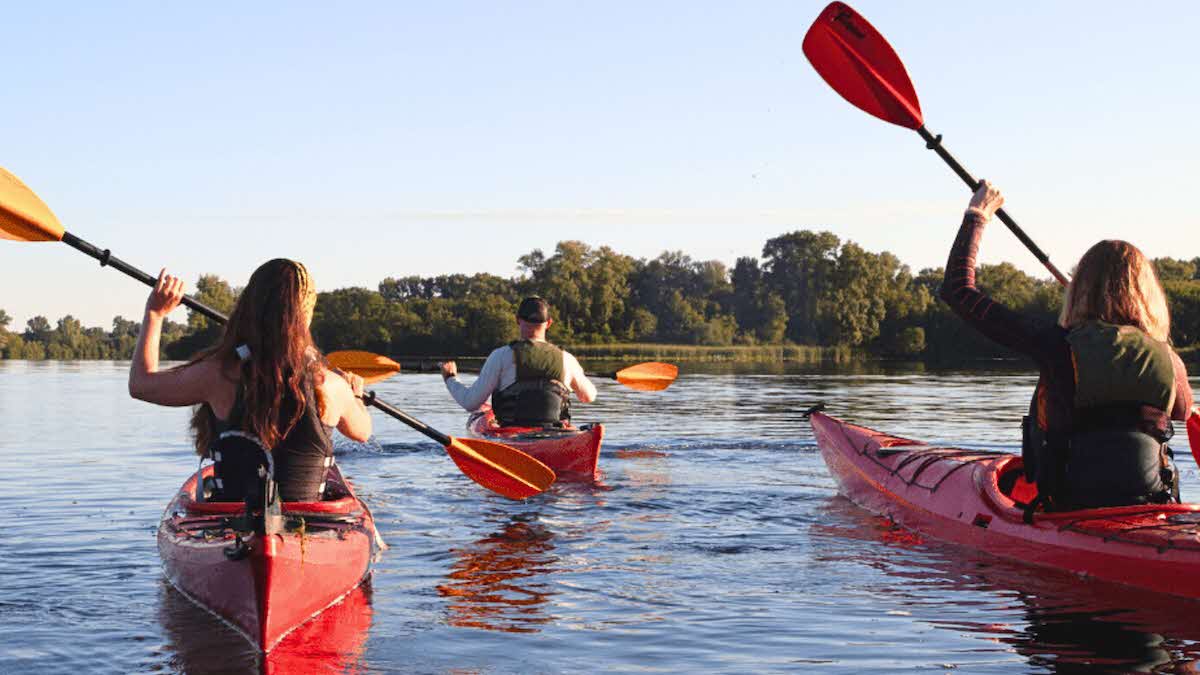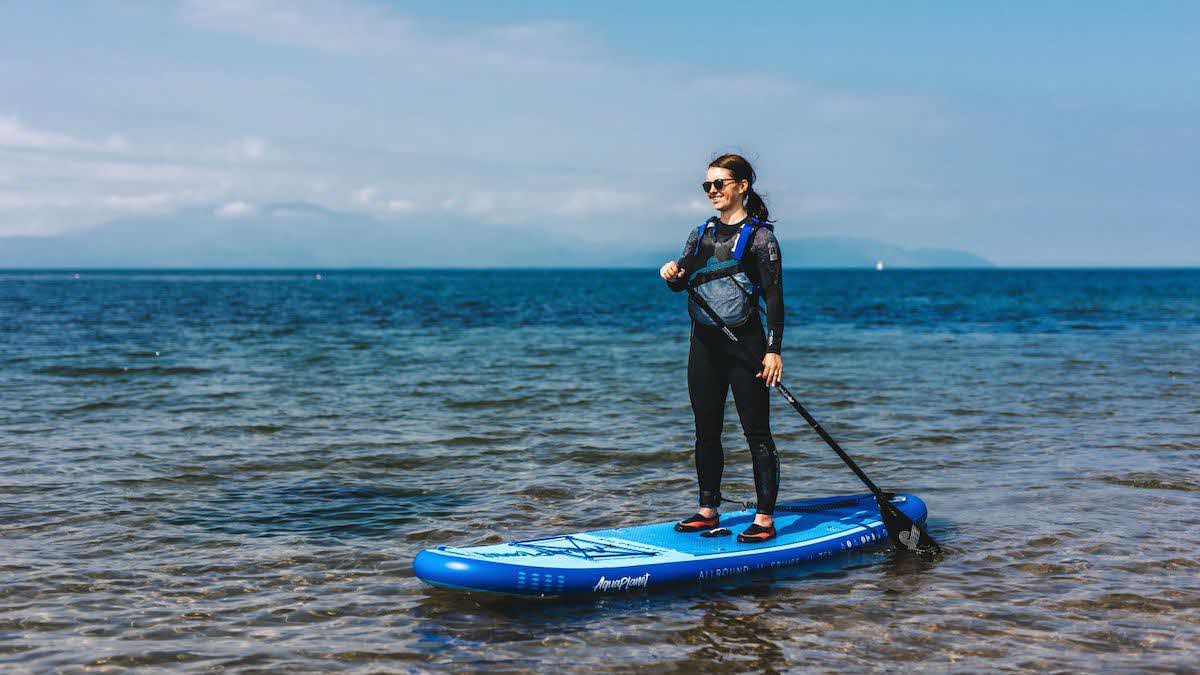Paddle time
Rob McCabe looks at canoeing, kayaking and paddleboarding in the second of four posts about watersports

Image courtesy of British Canoeing
First, let’s address the differences between a canoe and a kayak. Perhaps the ultimate tip is to look at the type of paddle that the boat’s user is holding. If it has a blade at either end, the craft is a kayak; if it’s a single blade, we’re talking canoe.
Next, the boat itself. A canoe is similar in layout to a traditional rowing boat in that the cockpit is open, and you either sit or kneel in it. A kayak is smaller and more streamlined than a canoe, and is often enclosed; you ease yourself down on to the seat with your feet in front, resting on a footboard. Sit-on-top kayaks are also widely used by watersports centres and hire outlets.
In general terms, canoes are better suited to pottering about, and leaner kayaks are for if you want to carve through the water with a bit more speed – but there’s nothing to say you can’t get a bit of a shift on in a canoe or glide serenely along in a kayak. Entirely up to you!
Whereas most kayaks are single-seaters, there are some on the market (and available at hire centres) that will accommodate two people. Canoes can be for two or three people, sometimes more, and it’s not that unusual to see the family dog coming along for the ride too – complete with pooch-specific buoyancy aid.
Ready to give it a go? Great. So how do you go about it? By far the best resource is the Go Paddling website, the aptly named, dedicated microsite of British Canoeing (BC), the organisation that looks after the interests of canoeing/kayaking – and canoeists/kayakers – across the UK. There, you can search your local area for instruction providers that offer the peace of mind of being designated a BC Delivery Partner, which means they meet BC’s standards of customer service, value for money and – crucially – safety. You’ll know that your teacher will be a qualified expert.
As a random test, I typed in the postcode of the small village in Fife where I grew up and immediately had the choice of five Delivery Partners within 20 miles. One of them is the fabulously monikered Och Aye Canoe, which deserves every success for its name alone.
Book a lesson at your chosen centre, and then simply turn up – they’ll supply a boat (a good start, I think you’ll agree), a paddle and a buoyancy aid. Packing a change of clothing is wise, especially if you’re kayaking, because the two-bladed paddles can cause a fair bit of splashing. In a canoe, you’re higher up so should stay drier.
And don’t get caught short by the good old British weather – the only thing you can safely predict with that is its unpredictability. Carry extra layers in a drybag – you can always take something off if you get too warm, but if you find that there’s a cutting, cold-edged breeze out on the water you’ll soon start to feel a bit miserable if you don’t have a fleece or windcheater. If unexpected rain clouds start to gather overhead, you can allow yourself a smug smile if you have a lightweight rain jacket ready to slip on. Keep a tube of high-factor sun cream handy, too – reflection off the water makes the sun’s rays stronger.
Kit-chat
So, you’ve had some instruction, you’re all genned up on the safety aspects and you’re ready to go out without an instructor. You’ve had roof bars fitted to the car, so now you need to go shopping for a canoe or kayak, depending on what most, er, floats your boat.
As with anything else, you can buy new or used – there’s no shortage of pre-owned canoes and kayaks on the usual online marketplace/auction sites – but you must be certain that whatever you buy is safe and undamaged. As a beginner, you may be more reassured by visiting a specialist retailer where you can browse the different options and try them for size.
You’ll see canoes with two, three or even four seats. Most are made of plastic, and are strong and relatively lightweight. Kayaks are lighter still and, again, there’s a wide range to choose from. Some offer built-in storage cubby boxes and even cup-holders – and doesn’t the very idea of grabbing a cappuccino from the watersports centre to sip as you practise your moves on the lake sound very civilised?
In England and Wales there’s another important purchase you’ll need to make before you pick up your paddle – a licence. More than 3,000 miles of lake, river and canal are accessible only to paddlers who possess a waterways licence, which you may be asked to produce at any time. Three separate authorities require a licence. The Canal & River Trust licence currently costs £53.71 and the Environment Agency one is £44.20. The Broads Authority, serving the eponymous National Park in Norfolk, charges £44.20.
That all adds up, admittedly. Good news, though – if you buy a British Canoeing ‘On The Water’ membership (£47 per year; discounted rates for families and couples), you’re automatically covered to go paddling anywhere that a licence is needed. Members in Wales can join Canoe Wales – same cost, same great access. In Scotland, ‘right to roam’ legislation means you don’t need a licence, but there are benefits to joining the Scottish Canoe Association. To find out about access to waterways in Northern Ireland, visit the Canoe Association of Northern Ireland website – again membership offers benefits (including discounts on kit and equipment hire).

Image courtesy of British Canoeing
Information
To find out more about the benefits of BC membership, see here. At the time of writing, the Club has a member offer discount which you can read about here.
Why canoe?
“Canoeing is an amazing way to experience life from a different perspective. From the water you experience things in a completely new way; from the wildlife around you, to the views of hills and forests. It is also a great escape from daily life – when you're on the water, it’s all you think about.”
James Ibbotson, British Canoeing
Paddling safely
Canoeing, kayaking and stand-up paddleboarding are fun activities but keeping yourself and others out of harm’s way should always be at the forefront of your mind. Here are some important safety tips:
- Donning a buoyancy aid (or personal flotation device; PFD) is a prerequisite.
- Plan your day before you set off – if the weather looks like it’s going to change for the worse, considering shortening or postponing your outing.
- Check river levels – simply log on to check-for-flooding.service.gov.uk/river-and-sea-levels, and enter a postcode or location into the search box. If you’re paddling in the sea, avoid offshore winds and head back towards the shore if you do encounter them.
- On rivers, be wary of fallen trees or overhanging foliage. Can you be completely certain there’s no obstruction under the water that’s going to cause you a problem? If not, get out of the water and walk around the obstacle. Check BC’s PaddlePoints website to ascertain if any hazards have been reported beforehand.
- Be confident in your ability to stop, turn and reverse your craft. As mentioned, proper tuition will equip you with the confidence and knowledge to always be in control. And make sure when you go paddling that you stay within your ability.
Your best resource? Without any doubt it’s gopaddling.info, which is awash with essential safety tips and informative videos.
What's SUP?

Image courtesy of Aqua Planet / British Canoeing
Stand-up paddleboarding (SUP) – it’s a genius idea, when you think about it. Just like surfing, you stand on a board and travel along the water. But because you use a paddle to propel yourself, you’re not reliant on waves and you don’t need to be anywhere near a coastline. You’re as likely to see a SUP on a river or lake as you are a calm inlet or a sheltered cove. Adrenaline junkies do go SUPping in more challenging water conditions, but generally paddleboarding is a serene activity – you’ll often see a parent paddling with a child sitting at the front, or a dog owner with pooch on board.
As with surfboards, there are different sizes and construction materials, but SUPs are generally longer and wider. Most are inflatable, which offers two benefits: greater stability because of the uniform shape and thickness when it’s fully inflated; and ease of storage when it’s not.
This is the second of four posts by Rob McCabe on watersports. Please click here to view the other parts: Part 1 | Part 3 | Part 4

